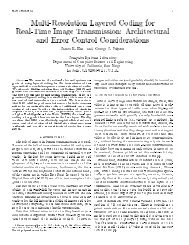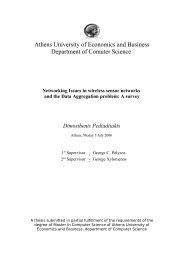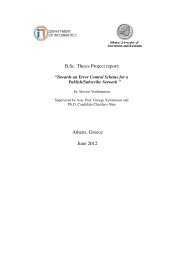The mobile phone as a platform for assisting the independent living ...
The mobile phone as a platform for assisting the independent living ...
The mobile phone as a platform for assisting the independent living ...
Create successful ePaper yourself
Turn your PDF publications into a flip-book with our unique Google optimized e-Paper software.
• Automate specific t<strong>as</strong>ks that a householder is unable to per<strong>for</strong>m (turning lightson or off)• Provide a safe and secure environment (alerting <strong>the</strong> householder of potentiallydangerous activities)• Alert helpers or carers should <strong>the</strong> householder be in difficulties (through linkingto a local community alarm scheme)• Enable and empower <strong>the</strong> user• Facilitate in <strong>the</strong> rehabilitation of householders (by giving prompts that beauditory and/or visual)2.3 Hierarchical cl<strong>as</strong>ses of smart homesDuring <strong>the</strong> p<strong>as</strong>t years <strong>as</strong> a result of technical developments <strong>the</strong> possibilities of smartenvironments have risen tremendously. This incre<strong>as</strong>e in possibilities is physically visiblein different types of realized smart homes. In order to cl<strong>as</strong>sify smart homes, a functionalperspective can be used. Since smart home technology is changing rapidly <strong>the</strong> functionalperspective provides a better framework than a technological point of view.With a focus on <strong>the</strong> functionality available to <strong>the</strong> user Aldrich [46] proposes fivehierarchical cl<strong>as</strong>ses of smart homes:• Homes which contain intelligent objects - homes contain single, standaloneapplications and objects which function in an intelligent manner• Homes which contain intelligent, communicating objects - homes containappliances and objects which function intelligently in <strong>the</strong>ir own right and whichalso exchange in<strong>for</strong>mation between one ano<strong>the</strong>r to incre<strong>as</strong>e functionality• Connected homes - homes have internal and external networks, allowinginteractive and remote control of systems, <strong>as</strong> well <strong>as</strong> access to services andin<strong>for</strong>mation, both within and beyond <strong>the</strong> home• Learning homes - patterns of activity in <strong>the</strong> homes are recorded and <strong>the</strong>accumulated data are used to anticipate users’ needs and to control <strong>the</strong>technology accordingly• Attentive homes - <strong>the</strong> activity and location of people and objects within <strong>the</strong>homes are constantly registered, and this in<strong>for</strong>mation is used to controltechnology in anticipation of <strong>the</strong> occupants’ needsSince broadband is becoming more widespread, available smart homes are shifting within<strong>the</strong> hierarchy from homes which contain intelligent, communicating objects to connected6








